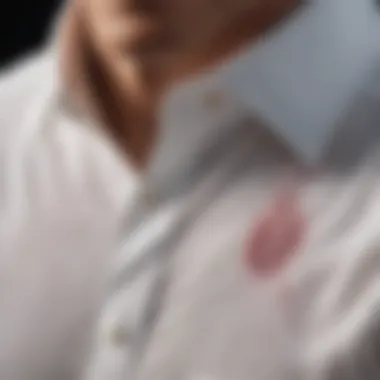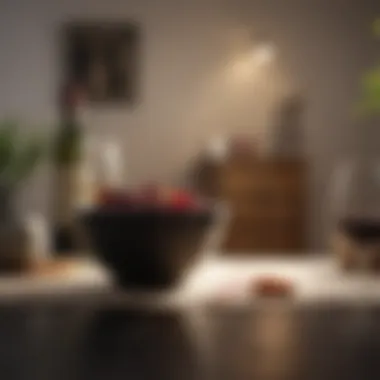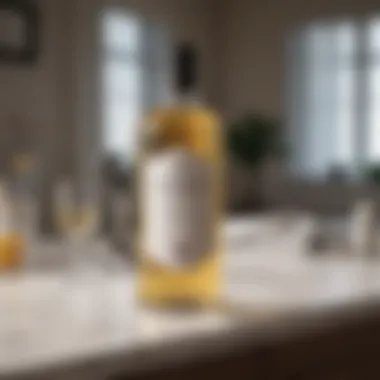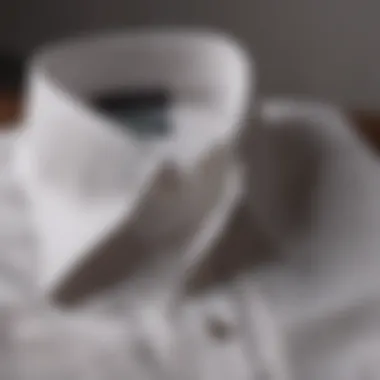Mastering Wine Stain Removal for White Shirts


Intro
Wine stains on white shirts represent a unique challenge. The vibrant color and acidity of red wine can easily lead to unsightly marks that seem impossible to remove. It's essential to understand both the nature of wine stains and the effective techniques available for treating them. This guide intends to provide concrete methods for dealing with these occurrences, whether you are hosting a party or simply enjoying a glass while dining.
Understanding the composition of wine is crucial. Red wine contains tannins, which are compounds that can penetrate fabric fibers, making stains difficult to eliminate. Immediate action is often the most effective course of action. Delaying can lead to more stubborn marks or even permanent discoloration through setting.
In the sections that follow, we'll delve into various household remedies, professional cleaning options, and practical tips for preserving the integrity of your white shirts. This comprehensive approach will arm homeowners and party hosts alike with the knowledge necessary to navigate the world of wine stains.
Understanding Wine Stains
Wine stains on fabric, especially white shirts, are a common concern for many individuals. Understanding the nature of these stains is crucial for effective removal. Wine is composed of various elements that contribute to its staining properties. Knowledge about wine stains can lead to faster and more efficient cleaning methods, ensuring that garments maintain their appearance and longevity.
Composition of Wine
Types of Wine and Their Staining Potentials
Different types of wine have varying levels of staining potential. Red wines, for example, tend to leave more prominent stains due to their deep pigments. White wines, on the other hand, might not show as obvious stains but can still cause discoloration. The intensity of the stain can depend on the specific grape variety and fermentation process used in producing the wine. Understanding these differences is essential when tackling wine stains because it allows one to tailor the cleaning approach based on the wine type.
Color Pigments and Their Effects on Fabrics
Color pigments in wine play a significant role in how stains interact with fabrics. Anthocyanins are the primary pigments found in red wine, and they are notorious for their capability to bind with fabric fibers. This binding can make stains particularly stubborn and difficult to remove. Moreover, lighter fabrics such as cotton or linen are more prone to staining than synthetic blends. Knowing the effects of color pigments can help in selecting appropriate cleaning methods that will be effective without damaging the shirt.
How Wine Stains Develop
Absorption and Setting of Stains
The process of stain development begins as soon as wine is spilled. When wine contacts fabric, it absorbs into the fibers almost immediately. The longer a stain sits, the deeper it penetrates, making it more difficult to remove. Initial reactions to a stain are pivotal; taking action quickly can prevent permanent setting. Hence, understanding how absorption works is vital for effective stain removal strategies that can mitigate damage to the fabric.
Factors Influencing Stain Severity
Several factors influence the severity of a wine stain, including the fabric type, the amount of wine spilled, and how quickly a response is initiated. For instance, porous fabrics absorb more liquid, leading to more significant staining. Temperature can also play a role, as heat can set the stain, complicating removal efforts. By comprehending these factors, individuals can make informed decisions in addressing wine stains effectively, increasing the chances of successful removal.
Immediate Response to Stains
Responding promptly to wine stains is crucial for effective removal. The first few minutes after a spill are vital. The longer the wine remains on the fabric, the deeper it can penetrate. By acting quickly, a significant chance exists to minimize or completely remove the stain. Immediate response also reduces the need for intensive cleaning measures, hence preserving the fabric integrity.
Initial Actions
Blotting Technique
The blotting technique is an essential first step when dealing with wine stains. It involves gently pressing a clean cloth or paper towel against the affected area. Rather than rubbing, which can spread the stain and embed it further, blotting lifts the liquid away. This technique is favored because it effectively absorbs excess wine without damaging the fabric.
It is important to use a clean cloth each time to avoid adding other stains to the situation. The key advantage of this method is its simplicity. They require no special materials or products, just a couple of towels or cloths. However, the flaw is that if done incorrectly, it can lead to a bigger mess.


Avoiding Common Mistakes
Avoiding common mistakes is paramount for effective stain removal. When one is in a hurry, the first reaction might be to scrub the stain vigorously. This often worsens the situation, pushing the wine deeper into the fibers. Another mistake is using hot water too soon. Heat can set the wine, making it more challenging to remove.
Recognizing these pitfalls can greatly enhance the success of the cleaning process. A key characteristic of this stage is that it focuses on mindfulness in the response. Taking a moment to assess rather than reacting impulsively usually yields better results. However, holding back from immediate action can be a disadvantage if too much time passes before a response begins.
Choosing the Right Approach
Home Remedies vs. Commercial Products
The choice between home remedies and commercial products can significantly impact the stance taken toward stain removal. Home remedies often use common household items, such as club soda or vinegar, that both individuals and eco-friendly consumers prefer. They are easy to access and often cheaper than store-bought solutions.
On the contrast, commercial products offer more targeted solutions that might be designed specifically for wine stains. Their effectiveness can outperform homemade methods, especially on stubborn stains. The choice boils down to personal preference and the severity of the stain. While home remedies are preferable for light spills, more intensive commercial products may be necessary for more severe incidents.
Assessment of Fabric Type
Assessing the fabric type plays a crucial role in deciding how to treat a wine stain. Different fabrics respond differently to stain removal techniques. For instance, cotton is usually durable and can withstand more aggressive cleaning methods. However, delicate fabrics like silk require a gentler approach.
Understanding the fabric can lead to a more tailored response, increasing the chances of successful removal. This assessment is an effective choice as it combines knowledge of material properties with practical application. Not considering the fabric can lead to permanent damage and wasted efforts. Each fabric requires a unique treatment plan to ensure the garment's longevity.
Home Remedies for Wine Stains
Home remedies provide accessible options to tackle wine stains, particularly for white shirts. They often utilize common household items, making them cost-effective and simple. Many people prefer these methods for their ease and reliability. Additionally, home remedies minimize risks associated with harsh chemicals found in commercial cleaners.
Club Soda Method
Application Process
The club soda method is straightforward and effective. Begin by immediately blotting the stain with a clean cloth to absorb excess wine. Next, pour club soda directly onto the stained area. The carbonation can help lift the stain from the fabric. Finally, blot again until the stain fades. This method stands out for its gentle approach, making it suitable for various fabrics.
Effectiveness on Different Fabrics
The effectiveness of the club soda method can vary depending on fabric type. It's most effective on cotton and polyester, where it tends to lift the stain without damaging the material. However, on delicate fabrics like silk, caution is needed. The unique feature here is its non-abrasiveness, which is crucial for preserving the integrity of lighter materials while effectively targeting the stain.
White Vinegar and Dish Soap
Ingredients and Ratios
A mixture of white vinegar and dish soap provides a powerful combination against wine stains. For optimal results, mix one part white vinegar with two parts dish soap. This specific ratio works well because vinegar’s acidity helps break down red wine, while dish soap acts to lift the stain. It is a beneficial choice due to its effectiveness and availability, making it a common household solution.
Step-by-Step Instructions
To use this method effectively, follow these steps: First, prepare the mixture in a bowl. Next, apply a small amount of the solution directly to the stain. Allow it to sit for about 30 minutes. Finally, rinse with cold water and launder as usual. The detailed approach is crucial for maximizing the solution's effectiveness, ensuring stains are treated comprehensively with minimal damage to the fabric.


Hydrogen Peroxide Solution
Safety Considerations
Hydrogen peroxide is potent but must be handled with care. Always wear gloves to protect your skin from irritation. Additionally, test the solution on a hidden section of fabric first, as hydrogen peroxide can bleach some materials. This precaution is vital when dealing with delicate fabrics, ensuring there is no unwanted discoloration. Its key characteristic is the strong oxidizing property, making it effective but necessitating careful handling.
Expected Outcomes
The expected outcome of using hydrogen peroxide is the effective removal of wine stains, especially on white shirts. When applied correctly, it can significantly reduce the visibility of difficult stains. However, the possibility of fabric damage exists, particularly with colored garments. This highlights the necessity of cautious use and testing before applying it to visible areas.
Commercial Products for Stain Removal
The presence of wine stains on white shirts can be particularly vexing. In this context, commercial products dedicated to stain removal become crucial. They often provide a level of efficacy that home remedies may not match. These products are specially formulated with active ingredients that target specific types of stains, including wine. Understanding their benefits and limitations can greatly enhance the chances of successful stain removal.
Effective Stain Removers
Types of Stain Removers Available
When it comes to effective stain removers, there are a few different types to consider. Enzymatic cleaners are popular because they break down proteins found in certain stains, making them easier to lift from fabric. Other formulations may include oxygen bleach, which is effective at removing organic stains, including those from wine. Additionally, solvent-based removers specifically target colorful and oily stains. Each of these types has its distinct characteristic which contributes to their effectiveness in stain removal.
- Key characteristic: Enzymatic products work best on fresh stains.
- Beneficial choice: Oxygen bleach is safe for colored fabrics.
- Unique feature: Solvent-based products can be harsh but effective on set-in stains.
- Advantages: They often deliver fast results.
- Disadvantages: Some can damage delicate fabrics if not used with caution.
How to Select the Right Product
Selecting the right stain removal product is critical. First, consider the type of fabric affected. Some solutions are safe for whites but not for colored textiles. Also, the age of the stain matters; older stains require more potent formulas. It is advisable to read the labels carefully to understand the active ingredients. Always look for a product that is suitable for cotton and blends as these fabrics are common for white shirts.
- Key characteristic: Compatibility with fabric type.
- Beneficial choice: Products with multiple cleaning agents can address diverse stains.
- Unique feature: Some products come with included applicators for better precision in application.
- Advantages: Effectively reduces staining risks with delicate fabrics.
- Disadvantages: Potential for uneven results if not applied correctly.
Pre-Treatment Options
Understanding Application Techniques
Application of stain removers can vary by product. Many require you to apply directly to the stain and allow it to sit for a specific duration. Some stain removers may need to be diluted with water, while others can be used at full strength. Knowing the proper technique is essential for maximizing effectiveness.
- Key characteristic: Application time can range from immediate to several minutes.
- Beneficial choice: Following specific product instructions helps avoid damage.
- Unique feature: Some pre-treatment products are designed to be used before washing, enhancing their efficiency.
- Advantages: They often provide deeper penetration into the fibers.
- Disadvantages: Incorrect timing can lead to poor results or fabric damage.
Expected Results and Limitations
Understanding what results to expect from commercial stain removers is vital. Most users seek complete stain removal, but this is not always possible, especially with older stains. Success can depend on the wine varietal, the fabric, and how quickly the treatment is applied. While many products can drastically lighten stains, some may leave a shadow, particularly on delicate fabrics.
- Key characteristic: Results may vary with the age of the stain.
- Beneficial choice: Reading user reviews gives insights into real-life efficacy.
- Unique feature: Some products come with a satisfaction guarantee which instills confidence in their effectiveness.
- Advantages: Many provide quick results when used correctly.
- Disadvantages: High expectations of complete removal can lead to disappointment.
Washing and Drying Process


The washing and drying process plays a critical role in effectively addressing wine stains on white shirts. The right techniques can substantially influence stain removal success. It is crucial to understand that not all washing methods are the same. Utilizing improper methods may set stains or even damage the fabric. Hence, selecting optimal strategies becomes paramount.
Optimal Washing Techniques
Temperature Considerations
Temperature considerations are an important aspect in washing stained shirts. Generally, warm water is preferred for stain removal. This is because it aids in breaking down the wine's pigments and components, making them easier to remove. This characteristic makes warm water effective in not only lifting the stain but also sanitizing the fabric. However, a unique feature of this method is the risk of damaging delicate fabrics when exposed to high heat. Therefore, always check the care label on the shirt before proceeding, as using water that is too hot may result in unintended consequences.
Detergent Recommendations
Different detergents have varied ingredient compositions, influencing their effectiveness against stains. Stain-fighting detergents often contain enzymes that target organic stains like wine. This helpful characteristic makes them particularly effective for removing difficult stains quickly. A notable feature of these detergents is their formulation for both cold and warm water, giving users flexible options. However, synthetic detergents could sometimes leave behind residues if not rinsed properly, hence it's important to use the recommended quantity.
Drying Methods
Air Drying vs. Machine Drying
When considering drying methods, it’s essential to choose between air drying and machine drying. Air drying is gentler on fabrics and minimizes the risk of shrinking or warping. This trait makes it a preferred option for delicate or stained items. On the other hand, machine drying may be quicker but can set any residual stains with heat, making them more difficult to remove. Hence, if opting for machine drying, it is advisable to use a low-heat setting, especially for recently washed garments.
Reassessing the Fabric After Treatment
Reassessing the fabric after treatment is a significant step in the cleaning process. This helps to determine whether the stain has been effectively removed. A key characteristic of this method is its role in preventing disappointment when wearing the shirt again. Checking for any signs of discoloration or lingering stains before drying is important as it allows for additional treatment if necessary. Ignoring this step can lead to assuming a successful removal when the stain is, in fact, still present.
Preventive Measures
Preventive measures are crucial for maintaining the quality and appearance of white shirts, especially in relation to wine stains. A proactive approach can significantly reduce the likelihood of stains setting in, allowing for easier management of potential mishaps. By understanding fabric choices and employing practical strategies during wine events, individuals can protect their garments and enjoy events without the constant worry about spillages.
Choosing the Right Fabric
Stain-Resistant Fabrics
Stain-resistant fabrics provide an extra layer of protection against spills and stains. They are manufactured using special treatments that repel liquids, making the fabric less absorbent. This key characteristic makes them popular choices for individuals who frequent wine events or social gatherings where the risk of spills is higher.
One unique feature of stain-resistant fabrics is their ability to withstand liquids for a short period. This quality allows time for the wearer to respond before a stain can set. However, it is essential to note that while stain-resistant options are beneficial, they may require more careful washing methods to maintain their protective qualities.
Best Choices for White Shirts
When selecting white shirts, considerations should be made for the fabric blend and weave. Fabrics such as polyester blends or treated cotton are excellent choices. They offer durability, and some level of stain resistance, and remain bright after multiple washes. This key characteristic makes them a wise investment for anyone concerned about maintaining a pristine appearance.
The unique feature of these blends is their resilience to frequent use and cleaning. However, while they resist stains better than traditional cotton, they may not be completely impervious. Understanding the balance between ease of cleaning and comfort is vital in making an informed decision about fabric choice.
Practical Tips for Wine Events
Utilizing Coasters and Napkins
Using coasters and napkins is a practical tip that minimizes exposure to spills during wine events. Coasters not only protect surfaces but also serve as a reminder of careful handling. Their availability encourages guests to set down their drinks securely, reducing the chance of accidents. This key characteristic emphasizes foresight in event planning.
Utilizing napkins also allows for quick clean-up of minor spills. It's a straightforward yet effective measure that can prevent larger stains from developing. However, these preventive tools require proper placement throughout the venue for maximum effect.
Choosing Beverage-Friendly Attire
When attending wine events, choosing the right attire can further diminish the risks of stains on white shirts. Opting for darker or patterned clothing can help camouflage any minor spills that may occur. This characteristic makes it a popular choice for those wishing to maintain an easy-going attitude at social functions.
Additionally, selecting appropriately fitted clothing can prevent unintentional contact with wine glasses, minimizing risk. However, while beverage-friendly attire offers certain advantages, it is essential for the wearer to remain vigilant about handling drinks delicately to fully avoid any mishaps.



